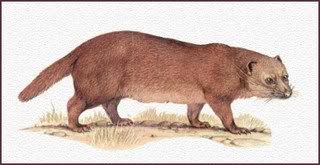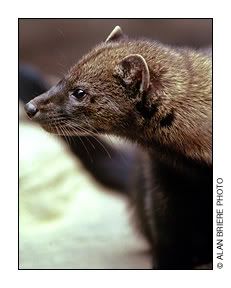
Monday, June 2, 2008
Otter Civet
Otter civet
Cynogale bennettii
SUBFAMILY
Hemigalinae
TAXONOMY
Cynogale bennettii Gray, 1837, Sumatra.
OTHER COMMON NAMES
English: Water civet; French: Civette-loutre de Sumatra; German: Mampalon; Spanish: Cibeta nutria.
PHYSICAL CHARACTERISTICS
Body length 23–27 in (57–68 cm), tail 5–8 in (13–21 cm), weight 6.5–11 lb (3–5 kg). The body is heavy and compact. The black legs are short and have naked soles and greatly curved claws. All feet are webbed, but the hind legs have less webbing than the forefeet. The broad, flat nose is well supplied with vibrissae. The nasal openings are on top of the nose, and the ears are rounded. The hair is yellowish gray-brown with a black-brown throat and lower lip. The chin and a spot over the eyes are yellowish white.
DISTRIBUTION
North Vietnam, Malaysia, Sumatra, Java, and Borneo.
HABITAT
Streams and swampy areas.
BEHAVIOR
Solitary, good climber, but not strong swimmer. Longevity may reach five years.
FEEDING ECOLOGY AND DIET
Crustacens, mollusks, fish, birds, small mammals, and fruits.
REPRODUCTIVE BIOLOGY
Litter size is two to three. Mating system is not known.
From Wikipedia
Wikipedia: Otter Civet
The Otter Civet, Cynogale bennettii, is an aquatic
The Otter Civet is
References
- Mustelid Specialist Group (1996). Cynogale bennettii. 2006
IUCN Red List of Threatened Species .IUCN 2006. Retrieved on 11 May 2006. Listed as Endangered (EN A1ce, C2a v2.3)
Carnivores of Mainland South East Asia, by Budsabong Kanchanasakha, WWF, Bangkok,
This entry is from Wikipedia, the leading user-contributed encyclopedia. It may not have been reviewed by professional editors (see full disclaimer)
Saturday, May 31, 2008
Friday, May 30, 2008
Fisher Cat

Definition:large, dark brown North American arboreal, carnivorous mammal.
In fact there is no such thing as a fisher cat. It's not actually a cat but rather a member of the weasel family.There are many theories as to why fishers are so often called fisher cats.
Another, is that the old French word for polecat, or fitchew, a European member of the weasel family, was fissau. This later became ficher (and then fisher or fisher cat) in English.
Still another theory is that fishers are widely blamed for devouring housecats that venture out for a stroll in the woods.
The fisher cat is coloured a deep brown and is a richly-furred handsome mammal.
The fisher typically measures between 30 and 41 inches in length.
A fisher cat can grow up to thirty pounds and is much larger than either the mink or the pine marten, two of its close relatives in the weasel family.
The Fisher Cat is a ferocious predator of small game and they are very fast on their feet.
he fisher cat is a resident of dense forests,and is a solitary creature and very elusive.
Few ever get the chance to see a fisher, mainly because they are nocturnal.
However,fisher cats can sometimes be heard calling in the woodlands during their mating season. They have a chilling scream very much like that of high-pitched child
Fishers, which in addition to eating small game will emit a shrill shriek when provoked, enjoy a rather exaggerated reputation as predators.




